All Categories
Featured

High-end vinyl floor covering has become a preferred choice for both domestic and industrial spaces, owing to its amazing capability to imitate the appearances of all-natural materials like wood and rock. This flooring remedy offers a cost-efficient alternative without jeopardizing on style or longevity. Making up several layers, luxury plastic is made to withstand everyday wear and tear, making it ideal for high-traffic locations and families with animals or youngsters.

There are mainly two sorts of luxury vinyl floor covering: high-end vinyl slabs (LVP) and high-end plastic floor tiles (LVT) LVP is crafted to simulate the appearance of hardwood slabs, supplying a warm and classic look, while LVT duplicates the appearance of stone or ceramic floor tiles, offering a sleek and contemporary aesthetic. Both choices are extra cost effective and much easier to maintain compared to their all-natural equivalents. In addition, innovations in modern technology have caused the development of variations like Timber Plastic Composite (WPC) and stiff core flooring, which improve the durability and durability of high-end vinyl.
One of the substantial advantages of high-end plastic flooring is its versatility in installation. Unlike traditional wood, which may not appropriate for moisture-prone locations, deluxe plastic's water-resistant residential properties make it suitable for basements, kitchens, washrooms, and mudrooms. Its resistance to scratches, scuffs, and dampness ensures that it maintains its look gradually, also in tough settings. Luxury vinyl gives a comfy underfoot experience and is simpler to replace than natural flooring materials, including to its functionality.

Check for more info at Carpet Interiors Floor & Home - Luxury Vinyl Guide Facebook Instagram Twitter Youtube
Latest Posts
Uncover the Best Auto Repair Deals in Montclare, Chicago
How to Know When Your Car Needs Skilled Auto Repair at Montclare Auto Repair
The Benefits of Regular Car Maintenance at Montclare Auto Repair Reduces Costs
More
Latest Posts
Uncover the Best Auto Repair Deals in Montclare, Chicago
How to Know When Your Car Needs Skilled Auto Repair at Montclare Auto Repair
The Benefits of Regular Car Maintenance at Montclare Auto Repair Reduces Costs